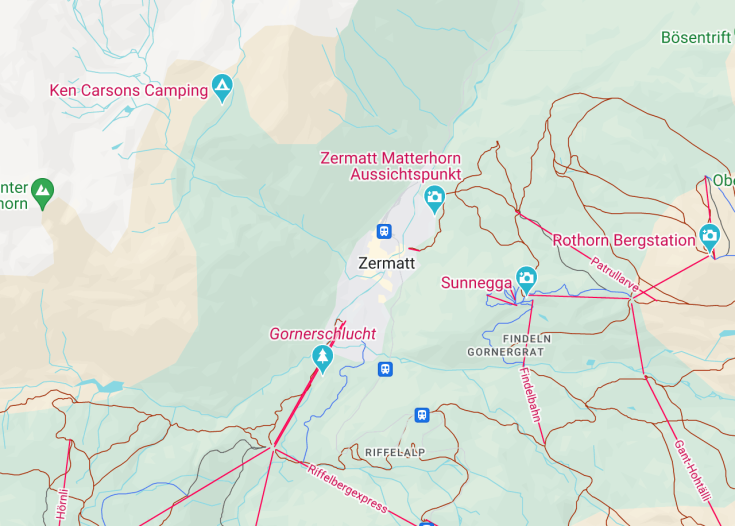Nestled in the Swiss Alps, Zermatt stands as a premier destination for both winter sports enthusiasts and summer adventurers. This picturesque village is famed for its strict car-free policy, encouraging a clean and quiet environment. Dominating the skyline is the iconic Matterhorn, one of the most photographed mountains in the world. Zermatt is not only about dramatic landscapes and skiing; it also offers gourmet dining, vibrant cultural scenes, and luxurious wellness centers, making it an all-year-round luxury retreat.
Prioritize visiting during the off-peak seasons of late spring or early autumn to enjoy Zermatt without the usual crowds, enhancing the tranquil experience of the mountains.
Consider booking your accommodation well in advance, as Zermatt’s popularity can lead to scarcity, especially during the ski season and summer months.
Zermatt: A Majestic Alpine Getaway
| Country | Switzerland |
| Time in Zermatt | GMT+2 |
| Language spoken | German |
| Population | 5,769 (source: Swiss Statistics, 2023) |
| Currency | Swiss Franc (CHF, ₣) |
| Airports |
|
Zermatt, nestled in the Swiss Alps, is a destination lauded not only for the iconic Matterhorn, which it faces, but also for its conservation efforts. As a car-free village, it offers pristine air quality and an unparalleled ambiance of tranquility. The town’s history stretches back to the Middle Ages, initially as a farming village and later evolving into a premier destination for mountaineering and winter sports. Nowadays, Zermatt is synonymous with mountain tourism, preserving its cultural heritage while innovative technologies ensure minimal environmental impact.
Where is Zermatt?
Zermatt is located in the southern part of Switzerland, nestled among the high peaks of the Pennine Alps.
Distances:
| Route | Distance by car | Time by car |
|---|---|---|
| Zurich to Zermatt | 216 miles (348 km) | Approx. 4 hours |
| Geneva to Zermatt | 149 miles (240 km) | Approx. 3 hours 30 minutes |
| Bern to Zermatt | 126 miles (203 km) | Approx. 2 hours 45 minutes |
What is Zermatt famous for?
Zermatt is celebrated worldwide for its dramatic and close-up views of the Matterhorn and a vast network of ski and hiking trails, making it a top choice for outdoor enthusiasts year-round.
History
Prehistoric to Medieval Times
The area now known as Zermatt was first inhabited by prehistoric tribes, evidenced by artifacts and etchings found in nearby caves. By the 13th century, the region had developed modest agricultural communities. The town’s strategic location along several trans-Alpine routes facilitated its growth as a trading hub between Swiss cantons and Italian regions.
14th Century to 19th Century
In the 14th century, Zermatt was officially recognized as a distinct community within the canton of Valais. Over the ensuing centuries, Zermatt endured through periods of economic fluctuations driven by farming and livestock. Its seclusion and challenging terrain also shielded it from major European conflicts, preserving its unique cultural heritage.
20th Century to Present
The 20th century marked a significant transformation for Zermatt, as it pivoted from a farming village to one of the world’s most renowned tourist destinations. The construction of the Gornergrat railway in 1898 opened up the area to tourism, which exploded with the advent of alpine skiing and mountaineering. Presently, Zermatt is celebrated globally for its skiing, climbing, and breathtaking alpine scenery, managed sustainably to preserve its natural and cultural heritage for future generations.
Visit Zermatt
What to see and do in Zermatt
Experience the breathtaking beauty of Zermatt, a premier destination in the Swiss Alps. Key attractions include:
- The Matterhorn: Synonymous with Zermatt, this iconic peak provides unmatched photo opportunities and climbing experiences.
- Gornergrat Railway: Take a scenic ride up to see sweeping views of the surrounding mountains and valleys.
- Matterhorn Glacier Paradise: Visit Europe’s highest cable car station for a panoramic view and year-round skiing.
- Zermatt Village: Stroll through charming streets with traditional chalets and bustling boutiques.
Engage in activities like skiing, hiking, and mountaineering depending on the season, or unwind at one of the many luxury spas and restaurants.
Events in Zermatt
Zermatt hosts various exhilarating events throughout the year. Notable are the Zermatt Music Festival and Academy in September, blending classical music performances with masterclasses, and the Patrouille des Glaciers, a famous ski mountaineering race held every two years in April. Each event showcases the unique culture and natural landscape of Zermatt, drawing visitors from around the globe.
Best time to visit Zermatt
The ideal time to visit Zermatt largely depends on the activities of interest. Winter months (December to April) are perfect for skiing and winter sports, whereas summer (June to September) offers excellent conditions for hiking, biking, and mountaineering. Each season in Zermatt presents a distinct charm, making it a year-round destination.
Is Zermatt worth visiting?
Zermatt is undoubtedly worth visiting for anyone who appreciates the natural beauty, outdoor sports, and distinct cultural experiences. The town offers a unique blend of historical richness, modern luxury, and breath-stealing natural scenery, set against the backdrop of one of the world’s most famous mountains, the Matterhorn. Whether you’re an avid skier, a trekking enthusiast, or simply someone in search of tranquility, Zermatt caters to all, making it a supremely rewarding destination.









